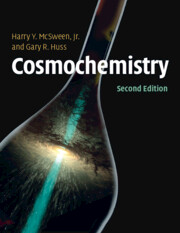Book contents
- Cosmochemistry
- Cosmochemistry
- Copyright page
- Dedication
- Contents
- Preface
- 1 Introduction to Cosmochemistry
- 2 Nuclides and Elements
- 3 Origin of the Elements
- 4 Solar System and Cosmic Abundances
- 5 Presolar Grains
- 6 Meteorites, Interplanetary Dust, and Lunar Samples
- 7 Element Fractionations by Cosmochemical and Geochemical Processes
- 8 Stable-Isotope Fractionations by Cosmochemical and Geochemical Processes
- 9 Radioisotopes as Chronometers
- 10 Chronology of the Solar System from Radioactive Isotopes
- 11 The Most Volatile Elements and Compounds
- 12 Planetesimals
- 13 Chemistry of Planetesimals and Their Samples
- 14 Geochemical Exploration
- 15 Cosmochemical Models for the Formation and Evolution of Solar Systems
- Appendix: Some Analytical Techniques Commonly Used in Cosmochemistry
- Glossary
- Index
- References
8 - Stable-Isotope Fractionations by Cosmochemical and Geochemical Processes
Published online by Cambridge University Press: 10 February 2022
- Cosmochemistry
- Cosmochemistry
- Copyright page
- Dedication
- Contents
- Preface
- 1 Introduction to Cosmochemistry
- 2 Nuclides and Elements
- 3 Origin of the Elements
- 4 Solar System and Cosmic Abundances
- 5 Presolar Grains
- 6 Meteorites, Interplanetary Dust, and Lunar Samples
- 7 Element Fractionations by Cosmochemical and Geochemical Processes
- 8 Stable-Isotope Fractionations by Cosmochemical and Geochemical Processes
- 9 Radioisotopes as Chronometers
- 10 Chronology of the Solar System from Radioactive Isotopes
- 11 The Most Volatile Elements and Compounds
- 12 Planetesimals
- 13 Chemistry of Planetesimals and Their Samples
- 14 Geochemical Exploration
- 15 Cosmochemical Models for the Formation and Evolution of Solar Systems
- Appendix: Some Analytical Techniques Commonly Used in Cosmochemistry
- Glossary
- Index
- References
Summary
Isotope fractionations and their causes in extraterrestrial materials, nucleosynthetic isotope anomalies
Keywords
- Type
- Chapter
- Information
- Cosmochemistry , pp. 165 - 191Publisher: Cambridge University PressPrint publication year: 2022

